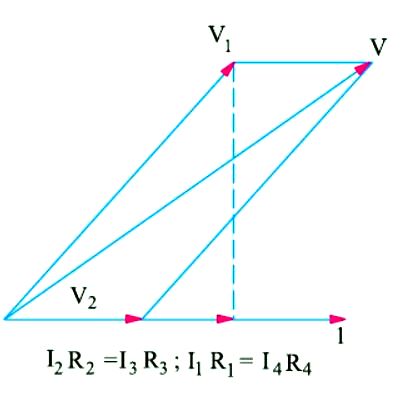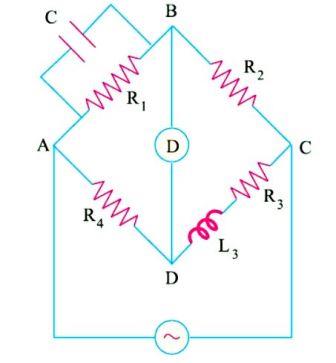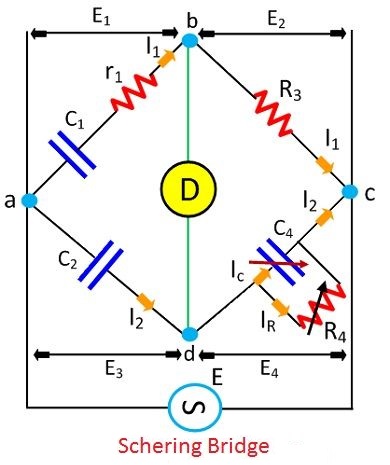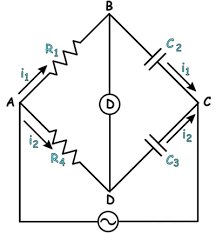Maxwell’s Inductance Bridge
The Maxwell’s Inductance Bridge circuit is used for medium inductances and can be arranged to yield results of considerable precision. As shown in Figure (A) in the two arms, there are two pure resistances so that for balance relations, the phase balance depends on the remaining two arms. If a coil of an unknown impedance Z1 is placed in one arm, then its positive phase angle φ1 can be compensated for in either of the following two ways:
(i) A known impedance with an equal positive phase angle may be used in either of the adjacent arms (so that φ1 = φ3 or φ2= φ4 ), remaining two arms have zero phase angles (being pure resistances). Such a network is known as Maxwell’s a.c. bridge or L1/L4 bridge.

(ii) Or an impedance with an equal negative phase angle (i.e. capacitance) may be used in opposite arm (so that φ1 + φ3 = 0). Such a network is known as Maxwell-Wien bridge (Figure (C)) or Maxwell’s L/C bridge.
Hence, we conclude that an inductive impedance may be measured in terms of another inductive impedance (of equal time constant) in either adjacent arm (Maxwell bridge) or the unknown inductive impedance may be measured in terms of a combination of resistance and capacitance (of equal time constant) in the opposite arm (Maxwell-Wien bridge). It is important, however, that in each case the time constants of the two impedances must be matched.
As shown in Figure (A),
Z1 = R1 + jX1 = R1 + jωL1 ……………….. unknown;
Z4 = R4 + jX4 = R4 + jωL4 …………………known
R2, R3 = known pure resistances; D = detector
AdBlock-2

The inductance L4 is a variable self-inductance of constant resistance, its inductance being of the same order as L1. The bridge is balanced by varying L4 and one of the resistances R2 or R3.
Alternatively, R2 and R3 can be kept constant and the resistance of one of the other two arms can be varied by connecting an additional resistance in that arm.
The balance condition is that Z1 . Z3 = Z2 . Z4
∴ (R1 + jωL1)R3 = (R4 + jωL4)R2
Equating the real and imaginary parts on both sides, we have
R1 . R3 = R2 . R4 or R1 / R4 = R2 / R3
(i.e. products of the resistances of opposite arms are equal).
and ωL1R3 = ωL4R2
L1 = L4 (R2/R3)
We can also write that L1 = L4 (R1/R4)
Hence, the unknown self-inductance can be measured in terms of the known inductance L4 and the two resistors. Resistive and reactive terms balance independently and the conditions are independent of frequency. This bridge is often used for measuring the iron losses of the transformers at audio frequency.
The balance condition is shown vectorially in Figure (B). The currents I4 and I3 are in phase with I1 and I2. This is, obviously, brought about by adjusting the impedances of different branches, so that these currents lag behind the applied voltage V by the same amount. At balance, the voltage drop V1 across branch 1 is equal to that across branch 4 and I3 = I4. Similarly, voltage drop V2 across branch 2 is equal to that across branch 3 and I1 = I2.

Read article – Units of Resistivity
Visit NCERTplanet.com for NCERT solutions and Textbook downloads




